***
Title: Mies y la gata Niebla. Ensayos sobre arquitectura y cosmopolítica
Author: Andrés Jaque. Office for Political Innovation
Editorial: Puente Editores. Printed in Spain, 2019. ISBN: 9788494969409
Language: Spanish
208 pages
***
“Architecture does not contain the social realm; It is the social realm itself. Architecture does not house humans. Following the findings of the actor-network theory, we can think that architecture is the interaction of a large number of different entities. There is no option for neutral architecture. The material devices are part of the chains of associations that make the daily life unfolds in some ways and not in others. (…) A constitution of human and non-human, of present and other generations to come, of the tacky, the cheesy and the affected, along with the austere and the optimized. A parliamentary architecture that, instead of guaranteeing the survival of the best or the normative, does it of those deprived of prestige, of the subversive and the repulsive, and that, instead of eliminating the disputes, what can only happen by simplification, control and imposition, mediate between them and build a problematic daily life.”
“La arquitectura no contiene lo social; es lo social. La arquitectura no aloja a los humanos. Siguiendo los hallazgos de la teoría del actor-red, podemos pensar que la arquitectura es la interacción de un gran numero de entidades diferentes. No existe la opción de la arquitectura neutral. Los dispositivos materiales forman parte de las cadenas de asociaciones que hacen que el día a día pueda transcurrir de unas maneras y no de otras. (…) Una constitución de humanos y no humanos, de generaciones presentes y otras por venir, de lo hortera, lo cursi y lo afectado, junto con lo austero y lo optimizado. Una arquitectura parlamento que, en lugar de garantizar la supervivencia de lo mejor o lo normativo, lo haga de aquello desposeído de prestigio, de lo subversivo y lo repulsivo, y que, en lugar de eliminar las disputas, lo que solo puede ocurrir por simplificación, control e imposición, medie entre ellas y construya una cotidianidad problemática.”
Page 18
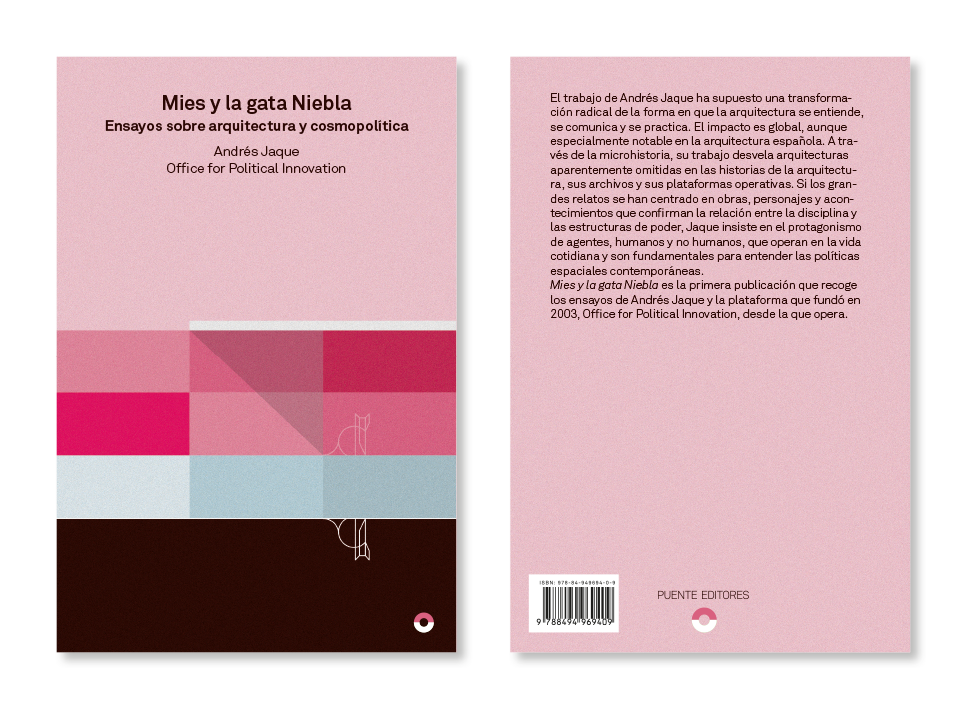

I guess I was in the third or fourth year of my studies when I discovered the architecture of Andrés Jaque. Somehow a small sketch came to me. Despite its simple appearance, it contained a great complexity and a whole manifestation of intentions. The small drawing presented a collection of data and analysis of different realities found in a specific physical place beyond the visual world. Several strokes in four or five colors defined the starting point for understanding the context of a small project located in Galicia. An understanding that was not limited only to the events or elements that were clearly visible, but sought to deeply collect a more complex reality by building a stronger intellectual basis for a given intervention.
Creo que estaba en tercer o cuarto año de carrera cuando descubrí la arquitectura de Andrés Jaque. De alguna manera llegó a mí un dibujo a mano de pequeño tamaño que, a pesar de su sencilla apariencia, encerraba una gran complejidad y toda una manifestación de intenciones. El pequeño dibujo presentaba una recogida de datos y análisis de realidades encontradas en un lugar físico determinado que trascendían el mundo de lo visual. Diferentes trazos en cuatro o cinco colores definían el punto de partida para el entendimiento del contexto de un pequeño proyecto ubicado en Galicia. Un entendimiento que no se limitaba tan sólo a los sucesos o elementos evidentemente visibles, sino que perseguía recoger profundamente una realidad más compleja construyendo un soporte intelectual más sólido para una intervención determinada.
For all those who have trained as architects in Spain since 2000, Andrés Jaque has been a main referent to develop a critical attitude capable of operating in contemporary societies, understanding or at least locating the different problems and conflicts within them. This revelation of realities often marginalized, or simply displaced by majority normalization, can build a much more sensitive and empathetic attitude capable of operating in more inclusive and tolerant way in architectural practice.
Para todos aquellos que nos hemos formado como arquitectos en España a partir de los 2000, Andrés Jaque ha sido una figura fundamental para poder desarrollar una actitud crítica capaz de operar en las sociedades contemporáneas, entendiendo o al menos localizando los distintos problemas y conflictos que las constituyen. Esta revelación de realidades muchas veces marginadas, o sencillamente desplazadas por la normalización mayoritaria, puede llegar a construir una actitud mucho más sensible y empática capaz de operar de forma más inclusiva y tolerante en la práctica arquitectónica.
The project “A Rolling House for the Rolling Society”, of 2009, probably has been a common reference in those who faced the exercise of projecting collective domestic spaces back in those years as students. Its strongly ideological approach, while pragmatic, sought to dismantle the rigidity of the domestic space corresponding to a traditional family model to house new social realities. These individuals or groups, mainly minorities, begin to relate and group in different ways than normalized through their interaction within the virtual spaces that social networks build. These spaces, overlapped to the physical structure of the cities themselves, generate opportunities to make visible what until then was kept undisclosed. The architectural practice aiming to understand these problems in order to respond to them must be able to include difference and uncertainty in the basis of their discourse and praxis.
El proyecto “A Rolling House for the Rolling Society”, del año 2009, probablemente haya supuesto una referencia habitual en aquellos que nos enfrentábamos al ejercicio de proyectar espacios domésticos colectivos. Su enfoque fuertemente ideológico, a la vez que pragmático, pretendía desarticular la rigidez del espacio doméstico correspondiente a un modelo de familia tradicional para albergar nuevas realidades sociales. Estos individuos o colectivos, principalmente minoritarios, comienzan a relacionarse y agruparse de formas distintas a las normalizadas mediante su interacción a través de los espacios virtuales que las redes sociales construyen. Estos espacios, superpuestos a la estructura física de lo urbano, generan oportunidades para visibilizar lo que hasta entonces se mantenía oculto. La práctica arquitectónica que pretenda comprender estas problemáticas para darles respuesta debe ser capaz de incluir en la base de su discurso y de su praxis la diferencia y la incertidumbre.
This ability to make visible elements or problems that the simplification or normalization of discourses keep hidden is probably the feature that would define Andrés Jaque’s work with greater accuracy.
Esta capacidad de hacer visibles elementos o problemas que la simplificación o normalización de discursos mantienen ocultos es probablemente el rasgo que definiría la obra de Andrés Jaque con mayor precisión.
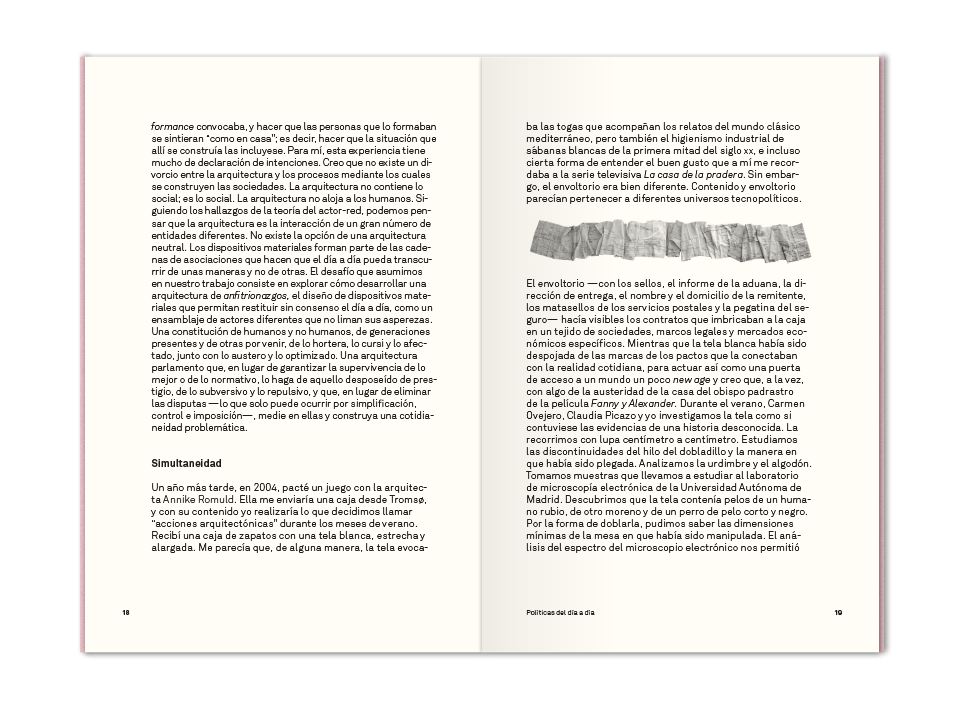
Years after those happy discoveries, and while we walk now on other paths, we find “Mies y la gata Niebla”, first compilation of texts by Andrés Jaque edited by Puente Editores. Among the twelve essays that make up this book, most of them had already been published over the last decade in different media. All of them, however, whether unpublished or not, have been reviewed by Andrés Jaque for the occasion and translated into Spanish, several for the first time, by the editor Moisés Puente. This exciting twelve-day trip traces a journey through the themes that the architect, from his Office for Political Innovation office, has researched and developed in recent years.
Años después de aquellos felices descubrimientos, y mientras caminamos ahora por otras sendas, nos encontramos con “Mies y la gata Niebla”, primera recopilación de textos de Andrés Jaque editada por Puente Editores. De los doce ensayos que componen este libro, la mayoría de ellos habían sido ya publicados a lo largo de la última década en distintos soportes o medios. Todos ellos, sin embargo, ya sean inéditos o previamente publicados, han sido revisados por Andrés Jaque para la ocasión y traducidos al castellano, varios por primera vez, por el editor Moisés Puente. Este emocionante viaje de doce jornadas traza un recorrido por los temas que el arquitecto, desde su oficina Office for Political Innovation, ha investigado y desarrollado en los últimos años.
When facing the critical review of this book, we discover our fear of awkwardly rewriting ideas or reasoning brilliantly exposed by Andrés Jaque in the development of his argument. That is why we have made the decision to limit ourselves to select some of the citations that we have found the most interesting in order to deploy an approach to the content of the book in a more honest and loyal way to reality. May the reader use this article to get a quick insight of the enormous value of these pages.
A la hora de afrontar la reseña crítica de esta obra, descubrimos nuestro temor a reescribir torpemente ideas o razonamientos brillantemente expuestos por Andrés Jaque en el desarrollo de su argumentario. Es por ello que hemos tomado la decisión de limitarnos a seleccionar algunas de las citas que hemos encontrados más interesantes con el objetivo de desplegar así de una forma más honesta y fiel a la realidad un acercamiento al contenido del libro. Sírvase de ellas el lector de este artículo para hacerse una imagen rápida del enorme valor que poseen estas páginas.
When on Monday, at the breakfast coffee, the gray routine returns to push us with its cadence, we will have the memory of those green years and that weekend getaway with Andrés Jaque over the optimism of building a more inclusive, rebel and resistant attitude with each of the realities that constitute our life. For the sake of a resistance capable of making architecture truly useful and necessary for all of them. Look for this essential book within one of the pockets of your coat and find, perhaps, the blue days and the sun of childhood.
Cuando el lunes, al café del desayuno, vuelva la rutina gris a empujarnos con su cadencia, nos quedará el recuerdo de aquéllos años verdes y aquélla escapada de fin de semana con Andrés Jaque por el optimismo de construir una actitud rebelde y resistente más inclusiva con cada una de las realidades que componen nuestra vida. Por un resistencia capaz de hacer de la arquitectura algo verdaderamente útil y necesario para todas ellas. Busquen en uno de los bolsillos de su gabán este libro que debería ser imprescindible en la formación de todo arquitecto y encuentren así, quizá, los días azules y el sol de la infancia.
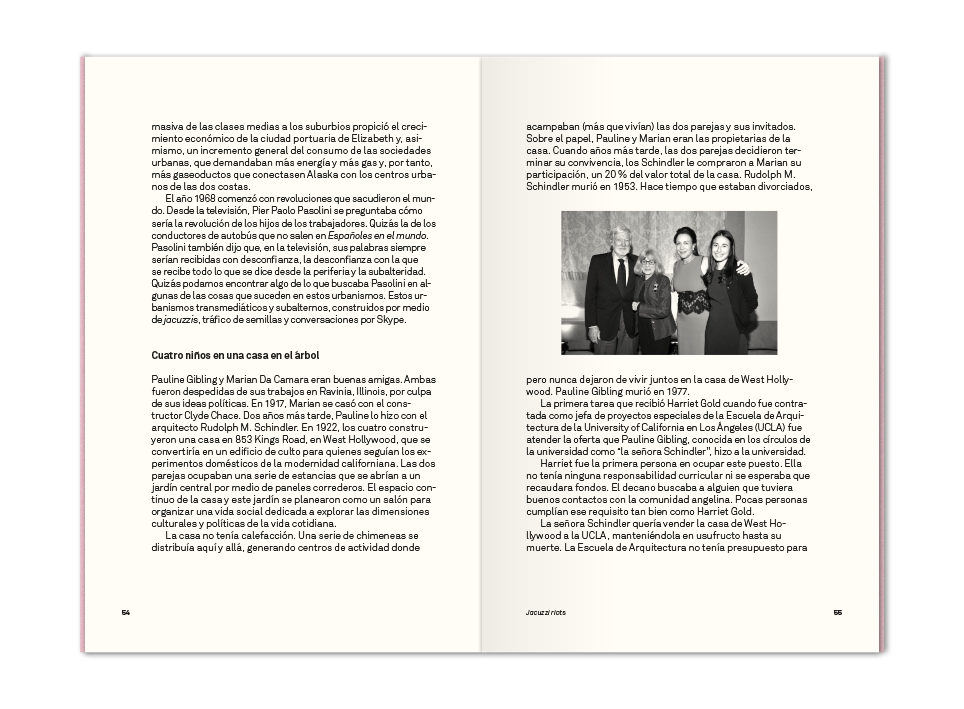
“This way of thinking, omnipresent both in the reconstruction and in the maintenance of the pavilion, supposes the unlikely possibility that ideas and circumstances function autonomously. This approach also suggests that, during the reconstruction process, it was considered that the value of the German pavilion was that which came from the unmediated translation of Mies’ thought into material architecture. The value of the pavilion was not taken into account as a result of the assembly and the dispute of a series of collective projects.”
“Esta forma de pensar, omnipresente tanto en la reconstrucción como en el mantenimiento del pabellón, supone la posibilidad improbable de que las ideas y las circunstancias funcionen de manera autónoma. Este enfoque también sugiere que, durante el proceso de reconstrucción, se consideró que el valor del pabellón aleman era el que provenía de la traducción no mediada del pensamiento de Mies a la arquitectura material. No se tuvo en cuenta el valor del pabellón como resultado del ensamblaje y la disputa de una serie de proyectos colectivos.”
Page 79
“The upper floor activates foundational notions of politics, policies in which the extraordinary, the origins, what it intends to last and the essences become the framework from which the collective is constructed. The basement, however, is the result of the encounter with the contingency and provisional agreements. The upper floor is transparent from a physical point of view, but it is constituted as an architecture that evacuates calculability, the possibility of measuring or scrutinizing, and invisibility of social pacts. The lower floor is opaque and, nevertheless, is the place where the contracts, experiments and controversies that make up the pavilion become visible. Together, the two floors build the pavilion as the false evidence of a fiction according to which the exceptional emerges from the ordinary.”
“La planta superior activa nociones fundacionales de política, políticas en las que lo extraordinario, los orígenes, lo que pretende durar y las esencias se convierten en el marco desde el que se construye lo colectivo. El sótano, sin embargo, es el resultado del encuentro con la contingencia y los acuerdos provisionales. La planta superior es transparente desde un punto de vista físico, pero esta constituida como una arquitectura que evacua la calculabilidad, la posibilidad de medir o escrutar, y que invisibilidad los pactos sociales. La planta inferior es opaca y, sin embargo, es el lugar donde los contratos, los experimentos y las controversias que conforman el pabellón se hacen visibles. Juntas, las dos plantas construyen el pabellón como la falsa evidencia de una ficción según la cual los excepcional emerge de lo ordinario.”
Page 95
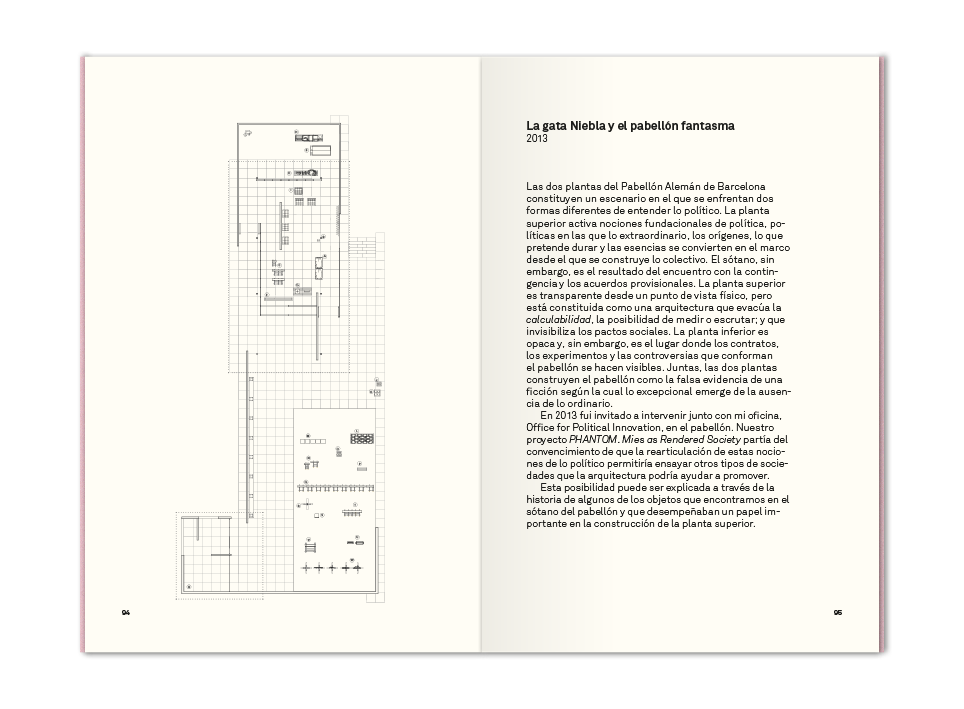
“The participation of urbanism in the production of inequality seems to be reaching a more sophisticated form of invisibility, following the invisibility provided to surrogates by California law firms, or the invisibility that limited liability corporations give to real estate owners. Close to building sites where migrants work, we might progressively begin to witness the appearance of tall, blond, affluent, successful business-humans, arriving to and departing from the Mandarin Oriental Hotels of the world with their well-cared-for parents, muscular-dystrophy-free bodies, and perhaps even a slight resemblance to James Franco or Ji Jin-hee. Working against this situation could be an interesting scenario for contemporary architecture and urbanism.”
“La participación del urbanismo en la construcción de la desigualdad puede estar alcanzando una forma de invisibilidad aún mas sofisticada que la que proporcionan los despachos de abogados californianos a las maternidades subrogadas o la que dieron las empresas con responsabilidad limitada a los propietarios de inmuebles. Cerca de los solares en obras donde trabajan personas que han migrado en busca de trabajo y que quizás se están viendo obligadas a vivir en cubículos como los de Jersey City, pronto podríamos empezar a ser testigos de la aparición de hombres y mujeres de negocios altos, rubios, ricos y con éxito que entran y salen de los hoteles Mandarin Oriental de todo el mundo, que cuidan por medio de las finanzas a sus tecnopadres, con cuerpos libres de distrofia muscular, y con un ligero parecido a James Franco o Jin Ji-hee. Esa es la posibilidad contra la que el urbanismo y la arquitectura contemporáneos pueden trabajar.”
Page 142
“The center of Milano 2 has never been occupied by the symbolic presence of religious or administrative power but, instead, by the Lago dei Cigni, the Lake of the Swans. The core of Milano 2’s infrastructure, which could be perceived as a pleasant architecture celebrating picturesque banality, also contained a sports and business center, schools, retail, a four- star hotel, and a park intended—according to the apartment sales brochures—to allow the children of Number Ones to play Cowboys and Indians and have organized treasure hunts. Together, these elements provided potential buyers of apartments with evidence of the way that Milano 2 would produce Number Ones and their children as competitive, healthy, earnest, aggressive, treasure-seeking, and athletic beings, prepared to occupy a position in a socially stratified world. In the way this infrastructure in Milano 2 is used even today, it can still be considered part of Edilnord’s project to shape bodies and societies through architecture and urbanism.”
“El centro de Milano 2 no lo ocupaba la presencia simbólica del poder religioso o administrativo, sino el “lago de los cisnes”. El núcleo infraestructural de Milano 2 podría percibirse como una inocente arquitectura placentera que celebraba la banalidad pintoresca, pero que en realidad agrupaba a su alrededor un centro deportivo y de negocios, escuelas, comercios, un hotel de cuatro estrellas y un parque. (…) Todos estos elementos proporcionaban pistas a los potenciales compradores de las viviendas de como Milano 2 convertiría a sus hijos en futuros números uno: competitivos, serios, agresivos, buscadores de tesoros y atléticos; preparados para ocupar un puesto privilegiado en el tipo de sociedad estratificada que la urbanización promovía. La manera como se utiliza incluso hoy esta infraestructura en Milano 2 puede considerarse parte del proyecto de Edilnord para moldear cuerpos y sociedades a través de la arquitectura y el urbanismo.”
Page 153
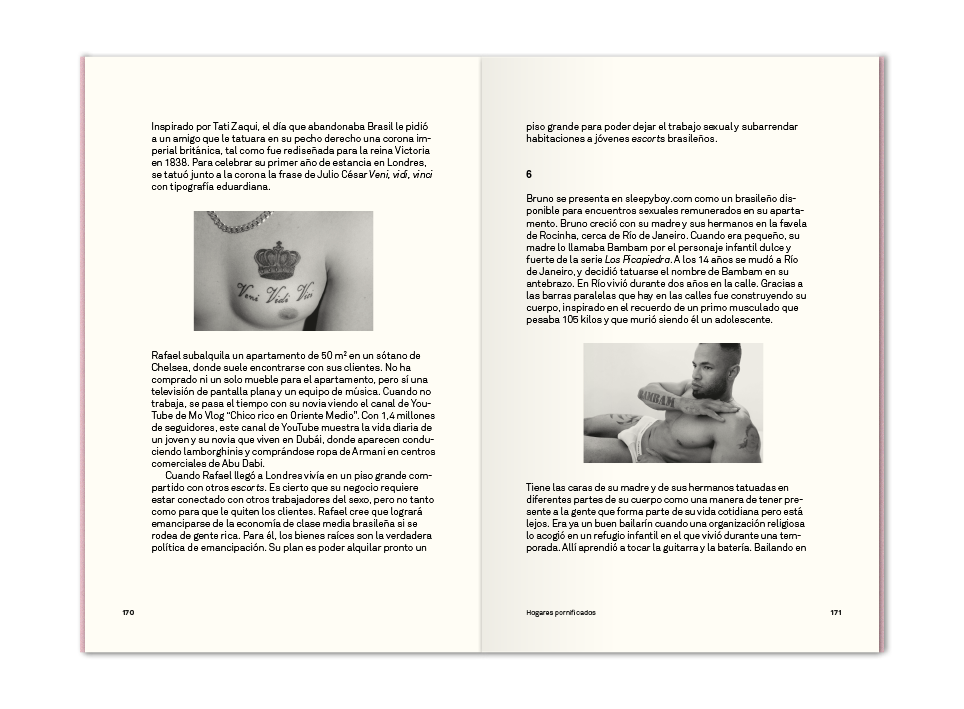
“Due to the growing normalization of LGBTQ lifestyles in Western countries, historical sites of queer empowerment have lost their role of accommodating the marginal and have become spaces of aspirational real-estate investment. If the queer movement historically challenged heterosexual couples as the respectable form of sexual allocation and claimed nightlife and trash as spaces for social justice, then the one-to-one relationship that Grindr’s interface prioritizes, and the progressive re- placement of gritty venues with bright apartments in former gayborhoods, marks an evolution in which gayness is less a victim and more an actor in the making of normative culture.”
“En muchas capitales occidentales, los lugares históricos del empoderamiento queer han dejado de alojar la alternativa, lo contraculturas, lo marginal y lo subversivo y, en su lugar, se han convertido en espacios de inversion inmobiliaria aspiracional diseñados para evacuar el riesgo de depreciación. Si históricamente el movimiento queer había desafiado a la pareja como el vehículo respetable de representación de lo sexual y reclamaba la vida nocturna y lo trash como espacios de empoderamiento y justicia social, las relaciones uno a uno que la interfaz de Grindr promueve, y la sustitución progresiva de los escenarios de lo queer por viviendas luminosas diseñadas como activos financieros que estabilizan el valor inmobiliario, marcan una evolución por la que lo gay deja de ser víctima y se convierte mas bien en un agente de creación de lo normativo.”
Page 180-81
